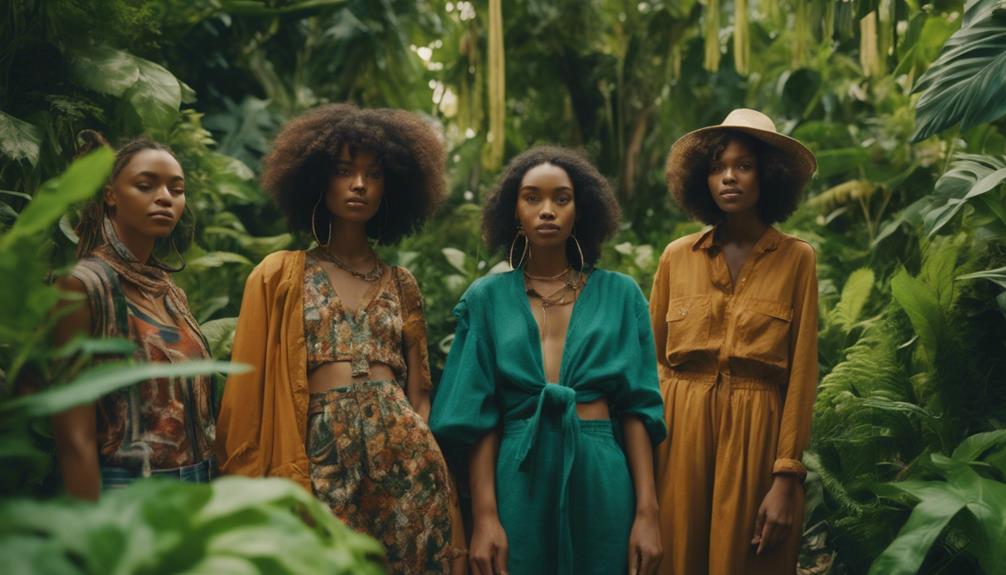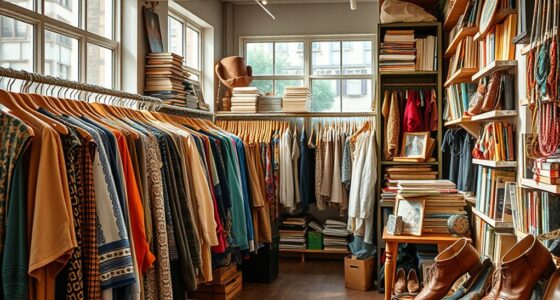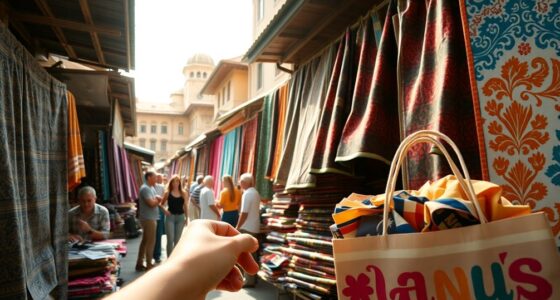Sustainable fashion revolves around reducing environmental impact and advocating for social responsibility. Opting for eco-friendly materials, such as organic cotton or recycled fabrics, helps decrease waste and pollution. It’s not only about following the latest trends, but also understanding the real consequences of fast fashion, which significantly adds to global emissions and waste. Fair labor practices play a crucial role in making sure workers are treated fairly. Be cautious of greenwashing – not every brand claiming to be sustainable truly is. When delving deeper into this subject, you’ll discover more eye-opening realities about making informed decisions that genuinely support sustainability.
Key Takeaways
- Sustainable fashion minimizes environmental impact by using organic and recycled materials, promoting waste reduction and resource efficiency throughout the garment lifecycle.
- It emphasizes fair trade practices, ensuring ethical treatment and adequate compensation for workers in the fashion industry.
- Fast fashion, which contributes significantly to global emissions and labor exploitation, contradicts the principles of sustainability.
- Misconceptions about sustainable practices, such as greenwashing and the efficacy of biodegradable materials, hinder informed consumer choices.
Definition of Sustainable Fashion
Sustainable fashion, often called eco-fashion, focuses on minimizing environmental impact and promoting social responsibility throughout the entire clothing lifecycle. When you think of sustainable fashion, consider how it influences every stage of a garment's life—from design and production to marketing and disposal. This approach aims to restore the environment while positively impacting society.
At its core, sustainable fashion is about waste reduction and resource efficiency. It encourages the use of organic and recycled materials, which greatly lessen the environmental harm typically associated with conventional textiles. You'll also find that sustainable fashion emphasizes fair trade practices, ensuring that workers are treated ethically and compensated fairly.
Given that the fashion industry is responsible for roughly 8% of global greenhouse gas emissions, adopting sustainable practices is more essential than ever. By understanding the definition of sustainable fashion, you can make informed choices that contribute to a healthier planet. Some examples of sustainable fashion trends include upcycling and recycling clothing, using eco-friendly and ethically sourced materials, and supporting brands that prioritize fair labor practices and transparent supply chains. By embracing these trends, individuals can help reduce the environmental and social impact of the fashion industry while still expressing their personal style. It’s important to stay informed about sustainable fashion trends and support companies that are dedicated to making positive changes for the future of our planet. Understanding the VS vs. rule can also help consumers make more sustainable fashion choices. This rule encourages individuals to consider the versatility and longevity of an item before making a purchase. By investing in timeless, high-quality pieces that can be worn in various ways and will last for years, consumers can reduce their overall consumption and contribute to a more sustainable fashion industry. Additionally, educating oneself about the environmental and social impact of the fashion industry can empower consumers to make more mindful purchasing decisions, ultimately leading to a more sustainable future for fashion.
As you explore your wardrobe, remember that each piece you choose can reflect your commitment to sustainability, making a difference in both the environment and society.
The Real Impact of Fast Fashion
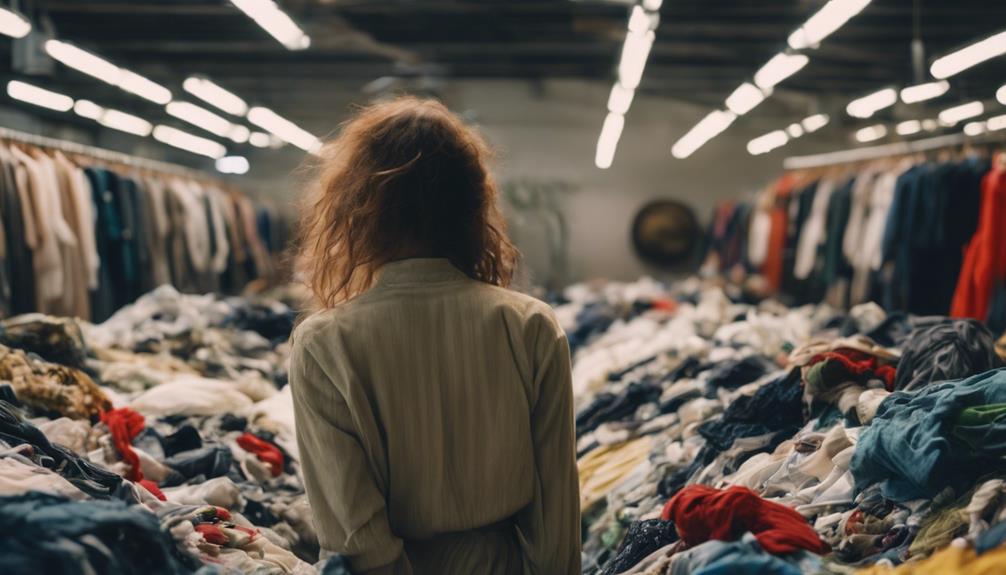
Fast fashion isn't just about trendy clothes; it's causing serious environmental harm and exploiting workers.
You might be shocked to learn that it produces a staggering amount of waste and emissions while relying on unfair labor practices.
Understanding these impacts can help you make more informed choices in your wardrobe.
Environmental Degradation Issues
The fashion industry substantially contributes to environmental degradation, with its practices driving climate change and water scarcity. You mightn't realize it, but every time you buy fast fashion, you're fueling a cycle that harms our planet. Sustainable brands are stepping in to combat these issues, but the damage is significant.
- The fashion industry is responsible for 8% of global greenhouse gas emissions.
- Around 20% of the world's wastewater comes from textile production.
- Fast fashion contributes to 20-35% of primary microplastics in oceans.
When you consider that producing just one pair of jeans requires about 7,500 liters of water, it becomes clear that conventional clothing manufacturing is unsustainable.
By choosing sustainable brands, you can help reduce this environmental impact. These brands prioritize eco-friendly practices, minimize waste, and promote ethical production.
Your choices matter—supporting sustainable fashion can lead to a healthier planet. It's time to rethink your wardrobe and make a difference for the environment.
Exploitative Labor Practices
While environmental degradation highlights the urgent need for change in the fashion industry, exploitative labor practices expose the human cost of cheap clothing. You mightn't realize that fast fashion brands often depend on these practices, with garment workers in developing countries earning as little as $3 a day—far below living wage standards.
About 80% of these workers are women, many facing unsafe conditions, long hours, and harassment without adequate protections. The reality is stark: over 40 million people work in forced labor conditions within this industry. They're trapped in cycles of debt due to low wages and poor working conditions.
When you reflect on that the average fast fashion worker produces around 1,000 garments a year, it's clear that the pressure to meet rapid production demands comes at the expense of their rights. Documentaries like 'The True Cost' reveal the ethical implications of your shopping habits.
If you want to support sustainable fashion, it's crucial to evaluate not just the environmental impact, but also the human cost behind the garments you buy. Opting for ethical brands can help change this alarming reality.
Common Misconceptions About Sustainability
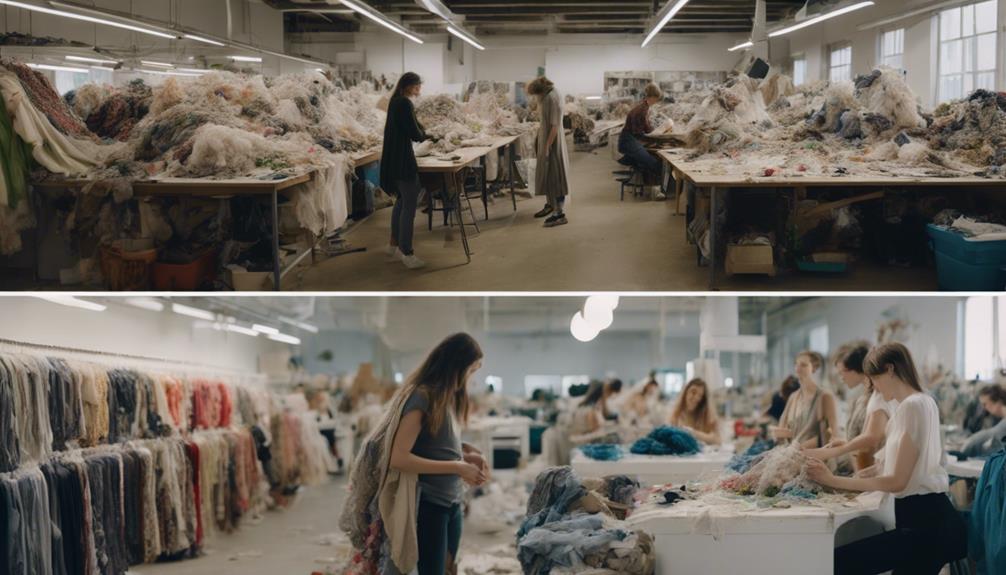
Many people assume that biodegradable materials solve sustainability issues, but they often come with their own set of environmental concerns.
For instance, these materials can take years to decompose, and during that time, they might release harmful microplastics into the ecosystem. You might also think that the term 'sustainable' guarantees eco-friendliness, but many brands misuse this label, engaging in greenwashing rather than genuine sustainable fashion practices.
Reflect on these common misconceptions:
- Biodegradable Equals Eco-Friendly: Not all biodegradable materials break down easily or safely.
- Green Labels Mean True Sustainability: Many products labeled as sustainable fail to take into account their entire lifecycle.
- Fast Fashion Isn't Sustainable: The culture of buying cheap, disposable clothes contradicts sustainability principles.
Understanding these misconceptions is vital for making informed choices about sustainable fashion.
Sustainable Practices in the Industry
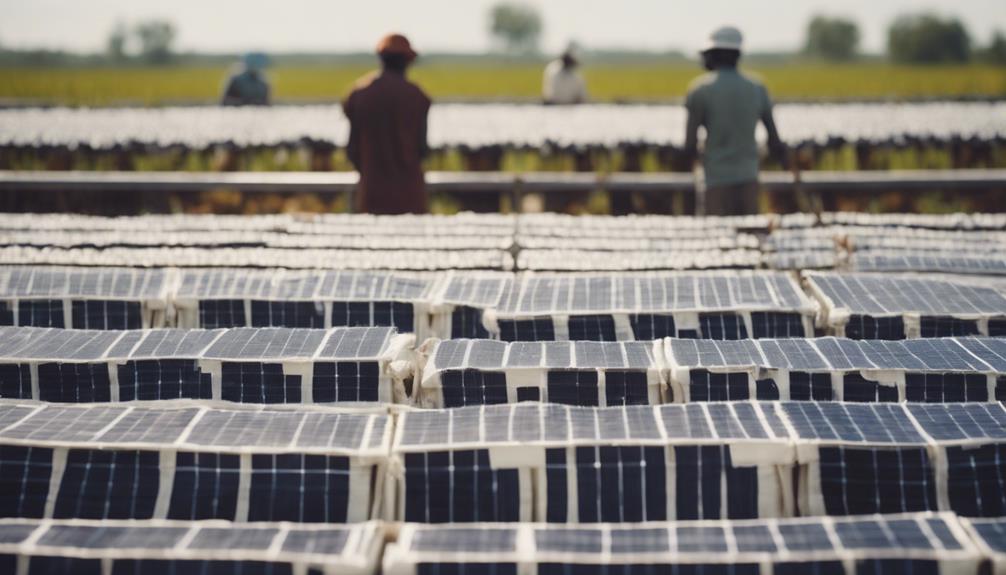
Sustainable practices in the fashion industry focus on reducing environmental impact through innovative materials and ethical labor standards. You'll find that many fashion brands are now prioritizing the use of organic cotton, hemp, and recycled materials to minimize their carbon footprint.
The industry contributes considerably to environmental degradation, accounting for 20% of global wastewater and 8% of greenhouse gas emissions. Because of this, adopting sustainable practices is essential.
Traditional fashion often involves chemical-intensive processes and harmful dyes that threaten water quality. By switching to eco-friendly alternatives, fashion brands can lessen their negative impact on ecosystems.
Additionally, fair labor practices are imperative. They guarantee workers are treated ethically and work in safe environments, making the supply chain more responsible and sustainable.
Innovation plays a key role in these practices. Technologies that enhance material sourcing and waste reduction strategies help promote a circular economy in the industry.
Choosing Eco-Friendly Clothing

When you choose eco-friendly clothing, material composition plays an essential role in minimizing your environmental impact.
Look for certifications and labels that guarantee sustainable practices, as these can guide you toward responsible brands.
Material Composition Matters
Choosing eco-friendly clothing starts with understanding the impact of material composition on the environment. In sustainable fashion, the materials you choose can greatly affect your ecological footprint. Opting for garments made from natural, organic, or recycled fibers not only supports the planet but also promotes healthier textile production practices.
Consider the following when selecting your clothing:
- Organic Cotton: Uses less water than conventional cotton, making it an eco-friendly choice.
- Hemp: Grows quickly and requires minimal pesticides, reducing environmental strain.
- Tencel: Made from sustainably sourced wood pulp, it's biodegradable and less harmful to the ecosystem.
Certifications and Labels
Certifications and labels play an essential role in helping you identify truly eco-friendly clothing options in a market often clouded by greenwashing.
When you see certifications like GOTS (Global Organic Textile Standard) or Oeko-Tex Standard 100 on a garment, you can trust that it meets strict environmental and social criteria. These labels indicate that the brand adheres to responsible practices, such as using organic or recycled fibers, fair labor standards, and minimizing chemical use, which collectively contribute to a sustainable approach.
Understanding these certifications is vital for you as a consumer. They help you differentiate between genuinely sustainable products and those that merely claim to be eco-friendly.
As you navigate through various options, knowing which labels to look for empowers you to make informed purchasing decisions. Research indicates that more consumers are willing to pay a premium for products with credible sustainability certifications, reflecting a growing desire for transparency in the fashion industry.
Brand Transparency Importance
Brand transparency is essential for understanding the true environmental and ethical impact of your clothing choices. When you prioritize eco-friendly clothing, knowing how brands operate can greatly influence your decisions. With a growing demand for accountability, consumers like you are more inclined to invest in sustainable products, as 92% of Indian adults show a willingness to pay more for them.
Consider the following points about brand transparency:
- Certifications like GOTS and Oeko-Tex Standard 100 signal responsible practices.
- Transparency in supply chains reveals the environmental effects of your choices.
- Radical transparency, as seen with brands like Everlane, builds trust but demands real ethical alignment.
Role of Technology in Sustainability
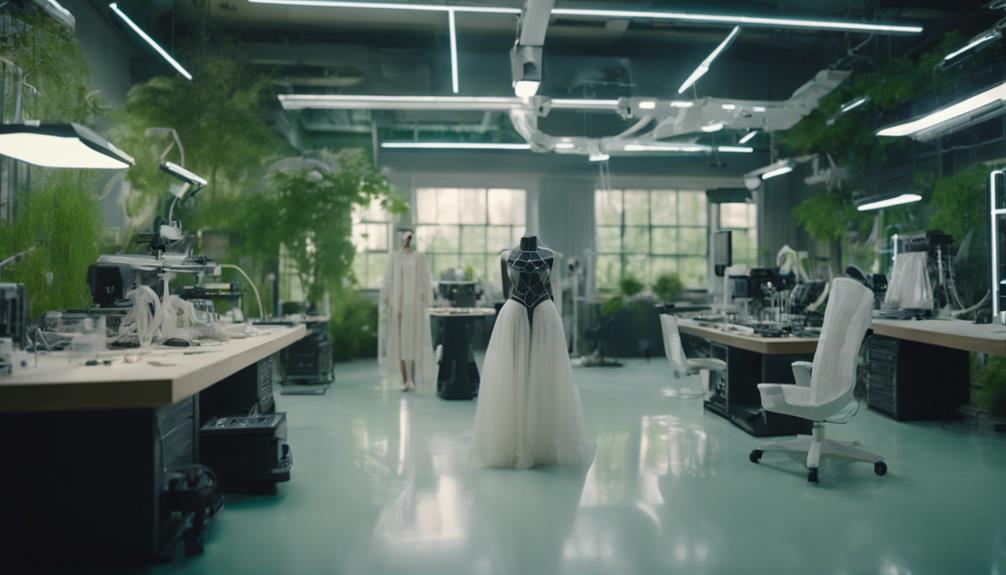
Technology greatly enhances sustainability in the fashion industry by introducing innovative materials and processes that reduce environmental impact. For instance, bio-based fabrics and advanced recycling methods improve how we source materials, making them more eco-friendly. You'll also find that data transparency tools, like blockchain, empower you to understand the environmental impacts of your purchases, ensuring you make informed choices.
Digital platforms and apps promote circular economy principles, allowing you to rent, resell, or swap clothing, which considerably reduces the need for new garment production. This shift not only lessens waste but also encourages a more sustainable approach to fashion consumption. Additionally, innovations such as 3D printing and automated cutting streamline manufacturing processes, cutting down on fabric waste and energy consumption.
Collaboration among brands, tech companies, and consumers is essential to leverage technology for sustainable advancements in the fashion sector. By working together, everyone can contribute to a more sustainable future.
Consumer Behavior and Sustainability

As consumers become more aware of sustainability, their purchasing choices increasingly reflect a desire for eco-friendly fashion options that minimize environmental impact. This shift in behavior is vital for driving the fashion industry toward more sustainable practices. By opting for sustainable brands, you're not just making a purchase; you're supporting a movement that values the planet.
- 92% of Indian adults are willing to pay more for sustainable products.
- Brands committed to sustainability can enhance customer loyalty.
- The average American discards 80 pounds of clothing annually.
Every decision you make as a consumer influences the demand for sustainable options. When you choose to buy from brands that prioritize eco-friendliness, you're helping to reduce textile waste and combat the disposable culture that has become so prevalent.
Mindful consumption is key; by carefully considering your clothing purchases, you can meaningfully impact the environment. Remember, your choices matter. By supporting sustainable fashion, you contribute to a healthier planet and a more responsible industry.
The Importance of Transparency
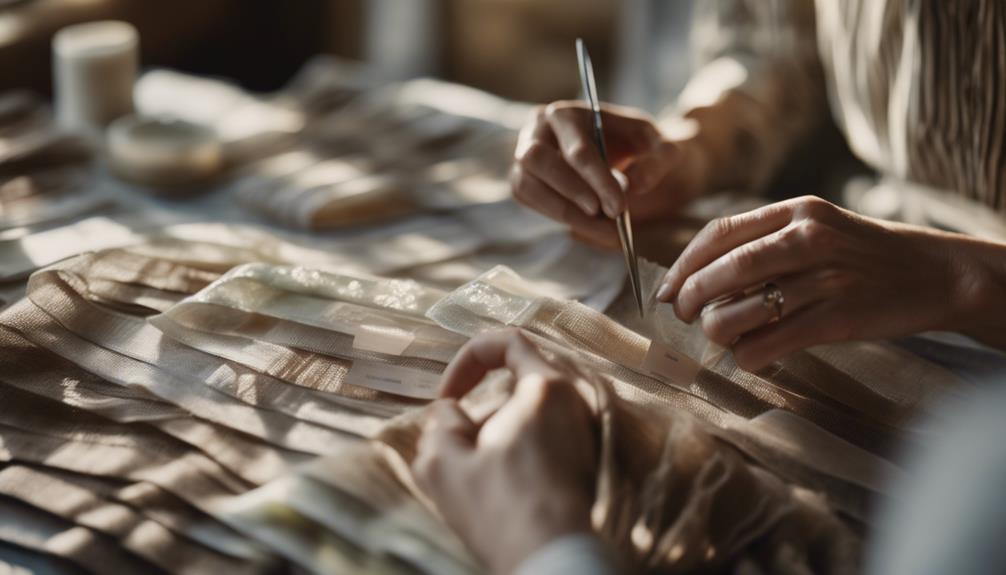
Transparency in the fashion industry builds trust and empowers consumers to make informed choices about the products they support. Brands that embrace transparency, like Everlane, strengthen their credibility. However, if they fail to uphold ethical practices, they risk losing that trust. With nearly 92% of Indian adults willing to pay more for sustainable products, the demand for transparency in pricing and production practices is clear.
Here's a snapshot of how transparency impacts consumer behavior:
| Aspect | Impact on Consumers |
|---|---|
| Trust | Builds loyalty and repeat purchases |
| Price Sensitivity | Willingness to pay more for transparency |
| Safety Claims | Informed decisions on product safety |
| Marketing Consistency | Aligns expectations with actual practices |
| Social Media Scrutiny | Heightens demand for accountability |
In a landscape where consumers increasingly scrutinize brands for their sustainability credentials, maintaining transparency in the fashion industry is not just beneficial—it's vital. The rise of social media only amplifies this demand, making it important for brands to align their marketing claims with actual practices to avoid eroding trust.
Future Directions for Sustainable Fashion

The future of sustainable fashion hinges on innovative practices and a collective commitment from brands, consumers, and policymakers to create a more responsible industry.
As you look ahead, it's clear that significant changes are on the horizon. The ethical clothing market is projected to reach USD 8.3 billion by 2025, indicating a shift towards sustainable consumer preferences.
To further this movement, consider these future directions:
- Biodegradable textiles: Innovations will lead to materials that decompose naturally, reducing landfill waste.
- Circular economy models: Emphasizing recycling and repurposing can minimize resource consumption and waste.
- Consumer education: Understanding sustainable practices helps you make informed purchasing decisions.
Frequently Asked Questions
What Is the Problem With Sustainable Fashion?
You'll find that sustainable fashion often falls short due to greenwashing, insufficient recycling, and fast fashion's overwhelming environmental impact. Many brands promote superficial initiatives, leading to confusion and limited genuine progress in sustainability.
What Is the Paradox of Sustainable Fashion?
The paradox of sustainable fashion lies in brands' claims versus reality. You'll notice many promote eco-friendly practices while still relying on harmful materials, leaving you questioning what truly constitutes sustainability in the fashion industry.
Do People Really Care About Sustainable Fashion?
You might be surprised, but many people do care about sustainable fashion. With rising awareness and the willingness to spend more, consumers increasingly seek brands that prioritize ethical practices over fast fashion's convenience.
What Are the 5 Rs of Sustainable Fashion?
The 5 Rs of sustainable fashion are Refuse, Reduce, Reuse, Recycle, and Repair. You can embrace these principles by avoiding fast fashion, buying less, extending garment life, transforming old clothing, and fixing damaged items.
Conclusion
In the end, embracing sustainable fashion isn't just a trend; it's a heartfelt commitment to our planet and future generations.
By choosing eco-friendly clothing and supporting transparent brands, you're not just dressing well—you're making a difference.
It's time to shed the weight of fast fashion's fleeting allure and step into a more mindful wardrobe.
Together, we can weave a brighter, more compassionate tomorrow, where style doesn't come at the cost of our world's well-being.
